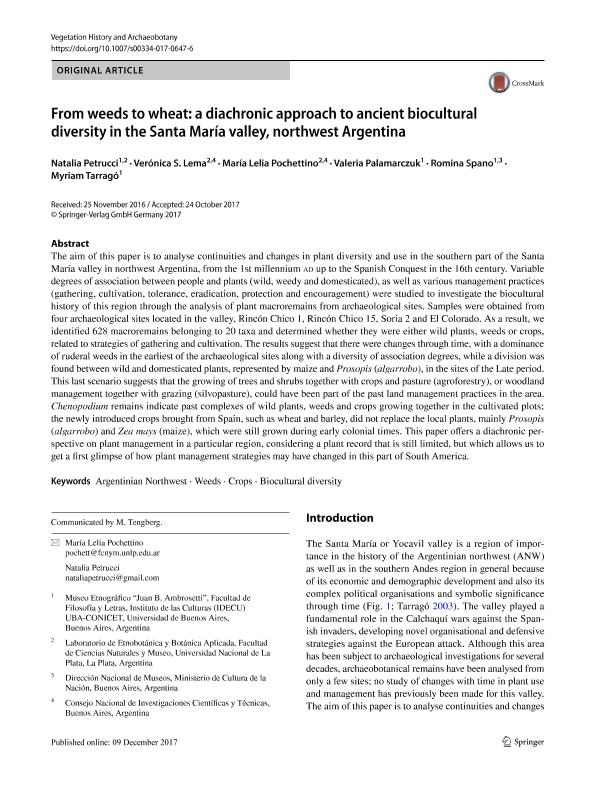Mostrar el registro sencillo del ítem
dc.contributor.author
Petrucci, Natalia Silvana

dc.contributor.author
Lema, Veronica Soledad

dc.contributor.author
Pochettino, María Lelia

dc.contributor.author
Palamarczuk, Valeria

dc.contributor.author
Spano, Romina Clara

dc.contributor.author
Tarrago, Myriam Noemi

dc.date.available
2018-03-16T19:20:51Z
dc.date.issued
2018-01
dc.identifier.citation
Petrucci, Natalia Silvana; Lema, Veronica Soledad; Pochettino, María Lelia; Palamarczuk, Valeria; Spano, Romina Clara; et al.; From weeds to wheat: a diachronic approach to ancient biocultural diversity in the Santa María valley, northwest Argentina; Springer; Vegetation History And Archaeobotany; 27; 1; 1-2018; 229-239
dc.identifier.issn
0939-6314
dc.identifier.uri
http://hdl.handle.net/11336/39130
dc.description.abstract
The aim of this paper is to analyse continuities and changes in plant diversity and use in the southern part of the Santa María valley in northwest Argentina, from the 1st millennium ad up to the Spanish Conquest in the 16th century. Variable degrees of association between people and plants (wild, weedy and domesticated), as well as various management practices (gathering, cultivation, tolerance, eradication, protection and encouragement) were studied to investigate the biocultural history of this region through the analysis of plant macroremains from archaeological sites. Samples were obtained from four archaeological sites located in the valley, Rincón Chico 1, Rincón Chico 15, Soria 2 and El Colorado. As a result, we identified 628 macroremains belonging to 20 taxa and determined whether they were either wild plants, weeds or crops, related to strategies of gathering and cultivation. The results suggest that there were changes through time, with a dominance of ruderal weeds in the earliest of the archaeological sites along with a diversity of association degrees, while a division was found between wild and domesticated plants, represented by maize and Prosopis (algarrobo), in the sites of the Late period. This last scenario suggests that the growing of trees and shrubs together with crops and pasture (agroforestry), or woodland management together with grazing (silvopasture), could have been part of the past land management practices in the area. Chenopodium remains indicate past complexes of wild plants, weeds and crops growing together in the cultivated plots; the newly introduced crops brought from Spain, such as wheat and barley, did not replace the local plants, mainly Prosopis (algarrobo) and Zea mays (maize), which were still grown during early colonial times. This paper offers a diachronic perspective on plant management in a particular region, considering a plant record that is still limited, but which allows us to get a first glimpse of how plant management strategies may have changed in this part of South America.
dc.format
application/pdf
dc.language.iso
eng
dc.publisher
Springer

dc.rights
info:eu-repo/semantics/openAccess
dc.rights.uri
https://creativecommons.org/licenses/by-nc-sa/2.5/ar/
dc.subject
Argentinian Northwest
dc.subject
Biocultural Diversity
dc.subject
Crops
dc.subject
Weeds
dc.subject.classification
Historia

dc.subject.classification
Historia y Arqueología

dc.subject.classification
HUMANIDADES

dc.subject.classification
Otras Ciencias Biológicas

dc.subject.classification
Ciencias Biológicas

dc.subject.classification
CIENCIAS NATURALES Y EXACTAS

dc.title
From weeds to wheat: a diachronic approach to ancient biocultural diversity in the Santa María valley, northwest Argentina
dc.type
info:eu-repo/semantics/article
dc.type
info:ar-repo/semantics/artículo
dc.type
info:eu-repo/semantics/publishedVersion
dc.date.updated
2018-03-12T19:32:38Z
dc.journal.volume
27
dc.journal.number
1
dc.journal.pagination
229-239
dc.journal.pais
Alemania

dc.journal.ciudad
Berlin
dc.description.fil
Fil: Petrucci, Natalia Silvana. Universidad de Buenos Aires. Facultad de Filosofía y Letras. Museo Etnográfico "Juan B. Ambrosetti"; Argentina. Universidad Nacional de La Plata. Facultad de Ciencias Naturales y Museo. Laboratorio de Etnobotánica y Botánica Aplicada; Argentina
dc.description.fil
Fil: Lema, Veronica Soledad. Consejo Nacional de Investigaciones Científicas y Técnicas; Argentina. Universidad Nacional de La Plata. Facultad de Ciencias Naturales y Museo. Laboratorio de Etnobotánica y Botánica Aplicada; Argentina
dc.description.fil
Fil: Pochettino, María Lelia. Consejo Nacional de Investigaciones Científicas y Técnicas; Argentina. Universidad Nacional de La Plata. Facultad de Ciencias Naturales y Museo. Laboratorio de Etnobotánica y Botánica Aplicada; Argentina
dc.description.fil
Fil: Palamarczuk, Valeria. Universidad de Buenos Aires. Facultad de Filosofía y Letras. Museo Etnográfico "Juan B. Ambrosetti"; Argentina
dc.description.fil
Fil: Spano, Romina Clara. Universidad de Buenos Aires. Facultad de Filosofía y Letras. Museo Etnográfico "Juan B. Ambrosetti"; Argentina. Ministerio de Cultura de la Nación. Dirección Nacional de Museos. Buenos Aires; Argentina
dc.description.fil
Fil: Tarrago, Myriam Noemi. Universidad de Buenos Aires. Facultad de Filosofía y Letras. Museo Etnográfico "Juan B. Ambrosetti"; Argentina
dc.journal.title
Vegetation History And Archaeobotany

dc.relation.alternativeid
info:eu-repo/semantics/altIdentifier/doi/http://dx.doi.org/10.1007/s00334-017-0647-6
dc.relation.alternativeid
info:eu-repo/semantics/altIdentifier/url/https://link.springer.com/article/10.1007%2Fs00334-017-0647-6
Archivos asociados
